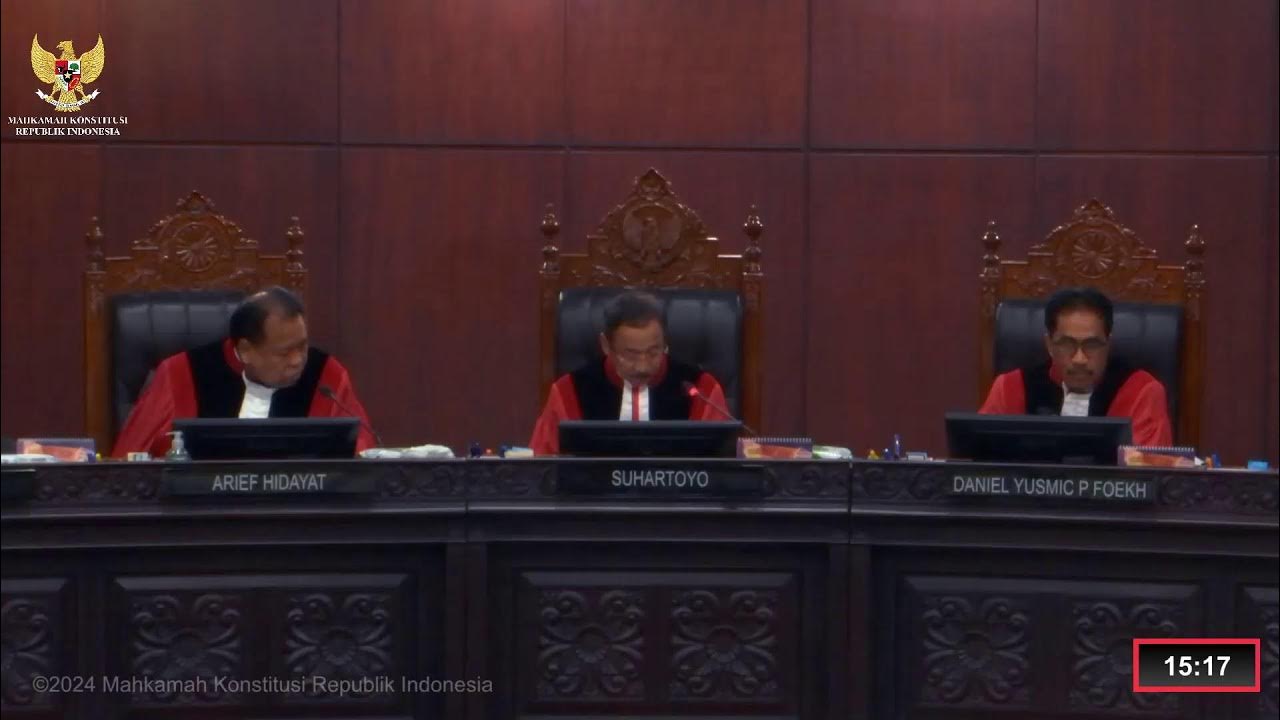Tahukah kamu Jenis Putusan Mahkamah Konstitusi (MK)
Summary
TLDRThe transcript delves into the intricacies of Constitutional Court rulings as outlined in Article 56. It emphasizes the significance of understanding the primary ruling (Amar) before assessing dissenting (disenting) and concurring (kkuring) opinions to avoid confusion. The discussion illustrates how decisions can emerge from a split among judges and highlights the role of majority votes in shaping the final ruling. It also points out that the Chief Justice's stance can greatly influence outcomes, thereby underscoring the importance of clarity in legal interpretations and the decision-making process.
Takeaways
- 😀 The Constitutional Court's decisions are categorized into three types: rejected ('No'), accepted ('Yes'), and partially accepted (kabul sebagian).
- 😀 Understanding the 'Amar' or judgment of the court is crucial before interpreting dissenting and concurring opinions.
- 😀 The position of judges plays a significant role in shaping the final decision, with those agreeing contributing to the majority opinion.
- 😀 Dissenting opinions should be contextualized within the framework of the Amar to avoid misunderstandings.
- 😀 The voting dynamics of the court allow for a decision to be made by a simple majority, which can lead to narrow margins.
- 😀 It's essential to grasp how many judges voted for each type of decision to understand the implications of the ruling.
- 😀 The discussion highlights that the ruling could potentially be determined by as few as three judges under certain circumstances.
- 😀 There is a specific legal framework outlined in Article 56 that guides how judges arrive at their decisions.
- 😀 Misleading interpretations can arise when one looks at dissenting and concurring opinions without first understanding the Amar.
- 😀 Emphasizing the context of the law helps clarify the discussions around judicial decisions in the Mahkamah Konstitusi.
Q & A
What types of decisions does Article 56 classify for the Constitutional Court?
-Article 56 classifies the decisions of the Constitutional Court into three types: kabul (accepted), tolak (rejected), and a hybrid decision which can be partially accepted.
What is the significance of 'Amar' in the context of the Constitutional Court's decisions?
-'Amar' refers to the core judgment or decision issued by the court, which is crucial to understand before analyzing dissenting or concurring opinions.
How should one interpret dissenting and concurring opinions according to the discussion?
-Dissenting and concurring opinions should be interpreted only after establishing the Amar, as the judges' positions become clear only in that context.
What role does the majority play in the decision-making process of the Constitutional Court?
-The majority rule, as stipulated in Article 45, dictates that the decision made by the majority of judges is the one that constitutes the court's ruling.
Can there be a scenario where a decision is split among the judges? If so, how is it resolved?
-Yes, there can be split decisions, such as a 3-3 vote. In such cases, the Chief Justice's stance becomes critical in determining which opinion prevails.
What is a potential consequence of not properly contextualizing the judges' opinions?
-Failing to contextualize the judges' opinions may lead to misleading interpretations regarding dissent and concurrence, which can distort the understanding of the court's decision.
What is the importance of understanding the composition of judges' opinions in the context of a ruling?
-Understanding the composition of judges' opinions helps clarify which judges support which aspects of the ruling and provides insight into the reasoning behind the court's decision.
How does the discussion suggest one should approach the analysis of court rulings?
-The discussion suggests that one should first establish the Amar before analyzing dissenting and concurring opinions to avoid confusion and ensure a proper understanding of the ruling.
What implications does the classification of decisions have on legal interpretation?
-The classification of decisions influences how legal interpretations are made, affecting the understanding of case law and the application of constitutional principles.
What are the possible outcomes if there are differing opinions among the judges?
-If judges have differing opinions, the possible outcomes include various forms of rulings that reflect the majority opinion or partial acceptance, leading to nuanced legal interpretations.
Outlines

Этот раздел доступен только подписчикам платных тарифов. Пожалуйста, перейдите на платный тариф для доступа.
Перейти на платный тарифMindmap

Этот раздел доступен только подписчикам платных тарифов. Пожалуйста, перейдите на платный тариф для доступа.
Перейти на платный тарифKeywords

Этот раздел доступен только подписчикам платных тарифов. Пожалуйста, перейдите на платный тариф для доступа.
Перейти на платный тарифHighlights

Этот раздел доступен только подписчикам платных тарифов. Пожалуйста, перейдите на платный тариф для доступа.
Перейти на платный тарифTranscripts

Этот раздел доступен только подписчикам платных тарифов. Пожалуйста, перейдите на платный тариф для доступа.
Перейти на платный тарифПосмотреть больше похожих видео
5.0 / 5 (0 votes)






